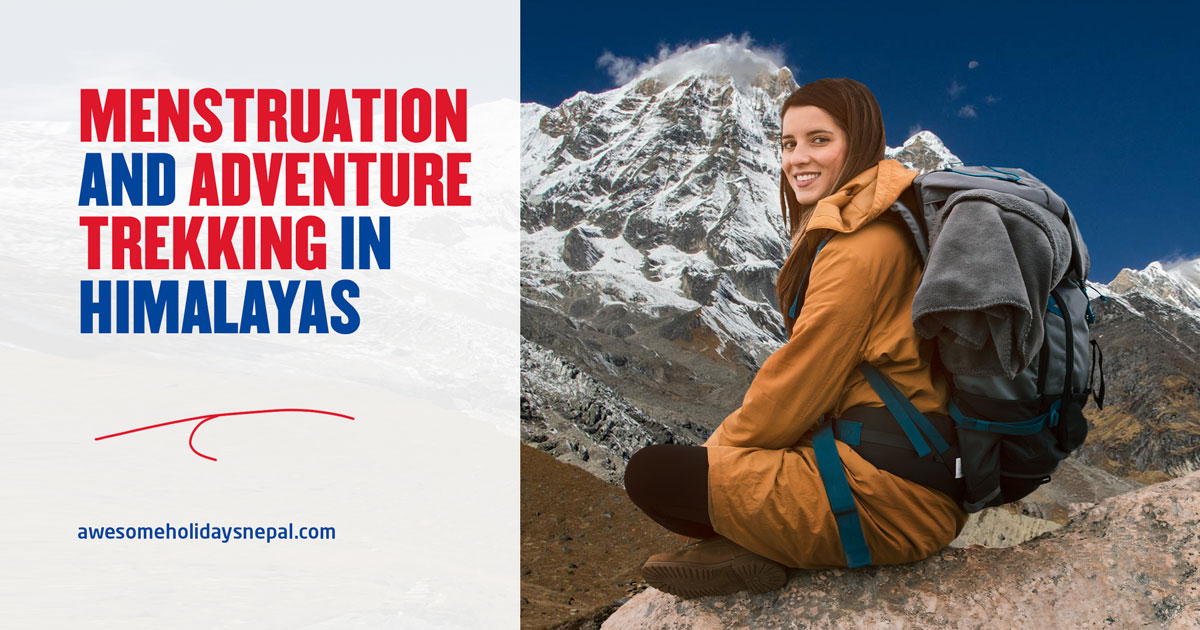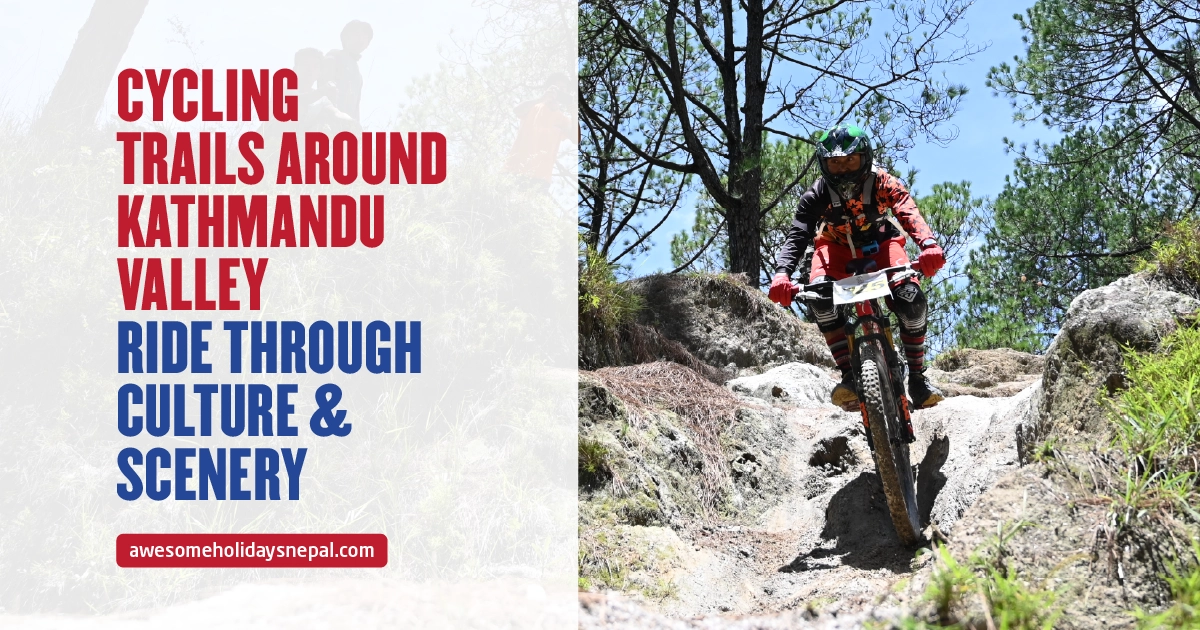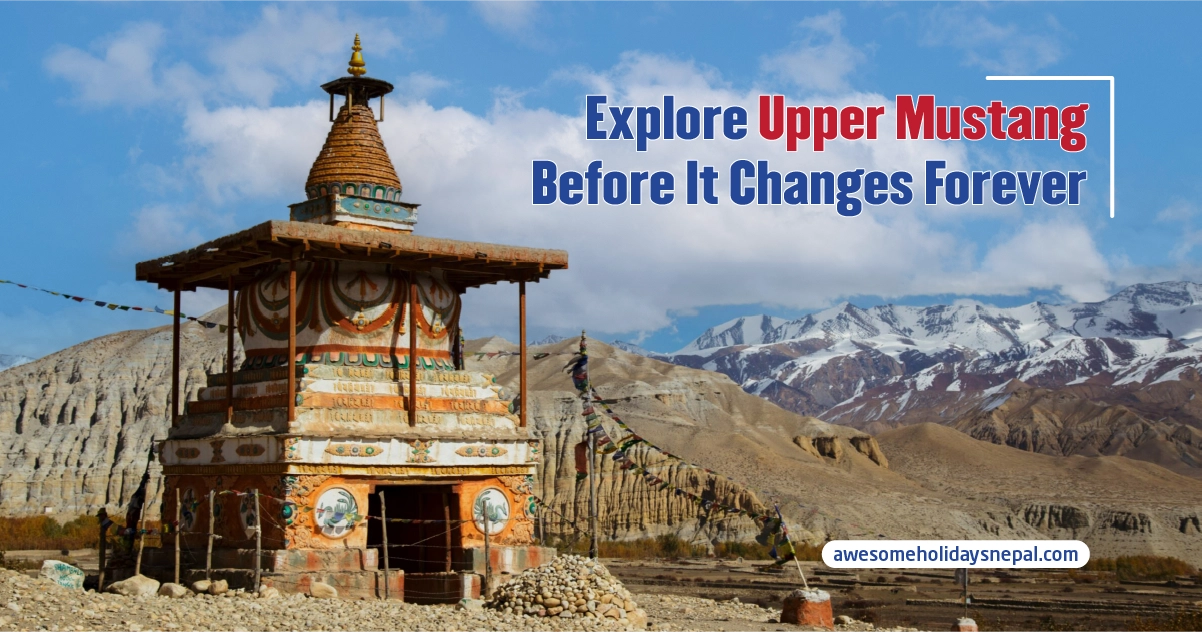Are you on your Periods During Trekking in the Nepal Himalayas?

Trekking in the Nepal Himalayas is a breathtaking adventure, but for women, menstruation periods during trekking come with additional challenges.
In Nepal, menstruation has historically been considered a taboo subject, making it even more important to be well-prepared.
Here’s a comprehensive guide to managing periods during trekking, covering essential tips, hygiene practices, and solutions to common problems.
How does Altitude affect Menstruation periods during trekking?
Everyone must understand that altitude can affect the menstrual cycle in different ways. At high altitudes, the atmospheric pressure is low, and the density of oxygen is lower than at sea level. This difference in atmospheric conditions can affect the menstrual cycle.
Some women experience irregular cycles, while others might have heavier or lighter bleeding. The change in oxygen levels and physical exertion may also lead to early or delayed periods during trekking in the high Himalayas. Understanding how your body responds to altitude changes can help you plan better.
There is already a risk of altitude sickness in the high Himalayas above 3000 m from sea level. In addition, your periods can cause cramps, nausea, and headaches, which can make your menstruation symptoms worse.

Common Period Problems During Trekking in the Himalayas
Trekking at high altitudes and in remote areas can intensify menstruation -related issues. Common problems include irregular cycles due to stress and altitude changes, increased cramps, and discomfort due to cold weather.
Physical exertion, difficulty managing hygiene due to limited access to clean water and toilets, and mood swings exacerbated by fatigue and changing hormone levels can be more of a nuisance for you. Your body’s changing hormonal levels can bring on mood swings exacerbated by fatigue.
In some trekking regions, proper disposable facilities may be limited. Sanitary pads do not decompose in the cold. Be mindful of the environmental effects during your trek.
Preparing for the Trek: Tips for Managing Periods During Trekking
Preparation is key to making your trek more comfortable. Track your cycle beforehand and plan accordingly. Choose the best period products that suit your needs, pack all necessary hygiene and pain relief essentials, stay hydrated, and maintain a balanced diet to reduce cramps and fatigue.
- Begin with the right mindset: Mentally prepare for both the trek and your period to maintain a positive attitude and stay focused on your objective.
- Carry suitable menstrual products: Select items that are comfortable, convenient to use, and easy to dispose of. Ensure you have enough supplies for the entire journey.
- Monitor your menstrual cycle: Keeping track of your cycle will help you anticipate your menstruation and plan your trek accordingly.
- Bring pain relief medication: Carry pain relievers to help ease cramps and other menstrual discomforts.
- Pack hand sanitizer and wet wipes: These essential hygiene items will assist in maintaining cleanliness during your trek.
Must-Have Essential Items for Managing Periods During Trekking
Having the right supplies can make period management much easier and ensure you stay clean and comfortable. Your trekking period kit should include menstrual products (pads, tampons, menstrual cups, or period panty), wet wipes and biodegradable toilet paper, Ziplock bags for waste disposal, pain relief medications, and hand sanitizer. You can make a Period Hygiene Kit including the following:
- Enough quantity of Pads/Tampons/Menstrual Cups (whatever you feel comfortable using)
- Sufficient number of cotton underwear and panty liners.
- Newspaper to wrap used items.
- Ziplocks or waterproof polythene bags.
- Biodegradable toilet paper/ tissue paper to clean yourself. It is not advised to use wet wipes as they are non-biodegradable.
- Hand sanitizer and soap
- Handkerchiefs or small towels (optional)
Dealing with Discomfort, Pain, and Cramps on Periods During Trekking
Trekking can worsen menstrual cramps, but natural remedies can help. Stay hydrated to reduce bloating and cramps. Consume warm herbal tea with ginger or chamomile. Apply a warm compress (like a heated water bottle) to the abdomen. Stretch and practice yoga poses to relieve tension.
Pain relief options include over-the-counter pain relievers, such as ibuprofen, as well as a heated water bottle, light exercises like stretching and walking, and deep breathing exercises to manage discomfort.

What About Mood Swings?
Mood swings are common during menstruation and can be intensified by altitude stress. Managing mood swings while being on periods during trekking includes staying hydrated, eating nutritious foods, and engaging in relaxing activities like meditation or journaling.
Bathroom Breaks: What to Do on the trail?
Finding a restroom while trekking can be difficult. Plan by using designated rest stops when available, finding secluded spots when necessary, carrying a trowel for digging a small hole, and carrying ziplock bags for proper waste disposal.
By preparing ahead and choosing the right products, managing your periods during trekking in the Himalayas can be made easier and more comfortable.
What’s the Best Replacement for Taking a Bath?
Finding a proper bathing facility on a trek can be challenging. Instead, use biodegradable wet wipes to clean yourself, carry a small towel and warm water for a sponge bath, and change into fresh clothes regularly to maintain hygiene.
Change your menstrual products regularly to avoid infections. Dispose of used sanitary products responsibly. Wash your hands before and after handling menstrual products.
Menstrual Cup vs Menstrual Pad: Which is Better for periods during trekking?
Choosing the right menstrual product is essential. A menstrual cup is eco-friendly, cost-effective, and lasts longer but requires cleaning with pure water. Otherwise, will be infected and create health hazards. On the other hand, a menstrual pad is easy to use but can cause discomfort and must be disposed of properly.

Social and Community Ethics
Though menstruation is a biological phenomenon, menstrual taboos still exist in some remote regions of Nepal. Be respectful of local customs while ensuring you follow hygienic practices. Please do not enter any temples if you are on your periods while trekking in the Himalayan region. This is not superstition, but it’s faith and respect for the god. If trekking with a group, communicate your needs discreetly and seek privacy when required.
What Medicines should be taken on periods during trekking?
Common medicines include pain relievers like ibuprofen and paracetamol, anti-nausea medication if altitude affects your stomach, and hormonal pills (consult a doctor before using them for period regulation).
Apart from these medications, the natural remedies like herbal tea, infused water can also help to ease the pain.

Will Blood Loss Affect Acclimatization?
Mild to moderate blood loss usually does not affect acclimatization. However, if you experience heavy bleeding and symptoms like dizziness, fatigue, or shortness of breath, immediately inform your guide and consult a medical professional as soon as possible.
Seek Professional Help: Medical Options for Period Management
If you have severe period symptoms or want to manage your cycle during the trek, consult a doctor for medical options like birth control pills to regulate or skip periods, prescription painkillers for severe cramps, and iron supplements if you experience heavy bleeding.
Don’t Let Yourself Stop
Being on your periods during trekking in the high Himalayas can be tricky if managed with the right preparation. By choosing eco-friendly menstrual products, maintaining proper hygiene, and being aware of cultural sensitivities, you can ensure a comfortable and hassle-free journey.
Menstruation should never hold you back from exploring the breathtaking mountains. With careful planning and confidence, you can fully embrace the adventure and make unforgettable memories in the heart of the Himalayas.
Pack your bag and come to Nepal, the country on your bucket list. Stay informed, pack wisely, and embrace the adventure with confidence!
FAQs
Expand AllIs it possible to trek in the Himalayas during my period?
Absolutely! You can trek while on your period. Many women successfully trek at high altitudes while menstruating. With the right preparation and hygiene measures, you can stay comfortable and continue your journey without major difficulties.
How can I maintain hygiene in remote mountain areas?
Better to use a menstrual cup, as it is reusable and minimizes waste. Bring biodegradable wipes, toilet paper, and zip-lock bags for the safe disposal of used products. Hand sanitizer and antibacterial wipes will be handy for cleanliness.
What if clean water is scarce?
Use sanitizing wipes to clean your hands and menstrual products when water is limited. If you have access to water, boiling it ensures better hygiene.
How can I manage period cramps at high altitudes?
You need to stay well-hydrated, keep warm with extra layers or a heat pack, and light stretching or yoga can also help ease discomfort. Taking pain relief medication like ibuprofen or paracetamol, if necessary, only on the recommendation of a doctor.
Can high altitude affect my menstrual cycle?
Yes, altitude changes may alter your period cycle and may cause irregular flow due to oxygen fluctuations, physical exertion, and stress on the body.
How do I dispose of used sanitary products when no facilities are available?
If no trash bins are accessible, place used products in zip-lock bags and carry them until you find a proper disposal point. Avoid burying or burning them, as they can harm the environment and do not decompose in colder regions.
What if I don’t have access to clean water?
Carrying sanitizing wipes or boil water when possible will be much better options.
Can trekking cause my period to come earlier or later?
Yes, intense physical activity, altitude changes, and travel stress may cause menstrual irregularities. It is common for periods to be delayed, arrive unexpectedly, or change in flow.
What essentials should I pack for managing my period during a trekking?
You need to have the following menstrual products (cups, tampons, or pads) as per your comfort.
- Wet wipes and toilet paper
- Hand sanitizer
- Zip-lock bags for safe storage of used items
- Pain relief medicine (with a prescription from a doctor)
- Extra cotton underwear and a small washcloth.
Are there cultural taboos about menstruation in Himalayan regions?
Some remote Himalayan communities follow traditional beliefs that restrict menstruating women from entering temples or certain religious places. While trekking, it’s good to be aware of these customs and respect local practices, though strict adherence may not be necessary.
Related blog posts
Discover a choice of tourist destinations loved by most of our visitors. Whether you're on a jungle safari to spot rare animals or walking through a world heritage site, these well-planned itineraries cover the major highlights of Nepal.




